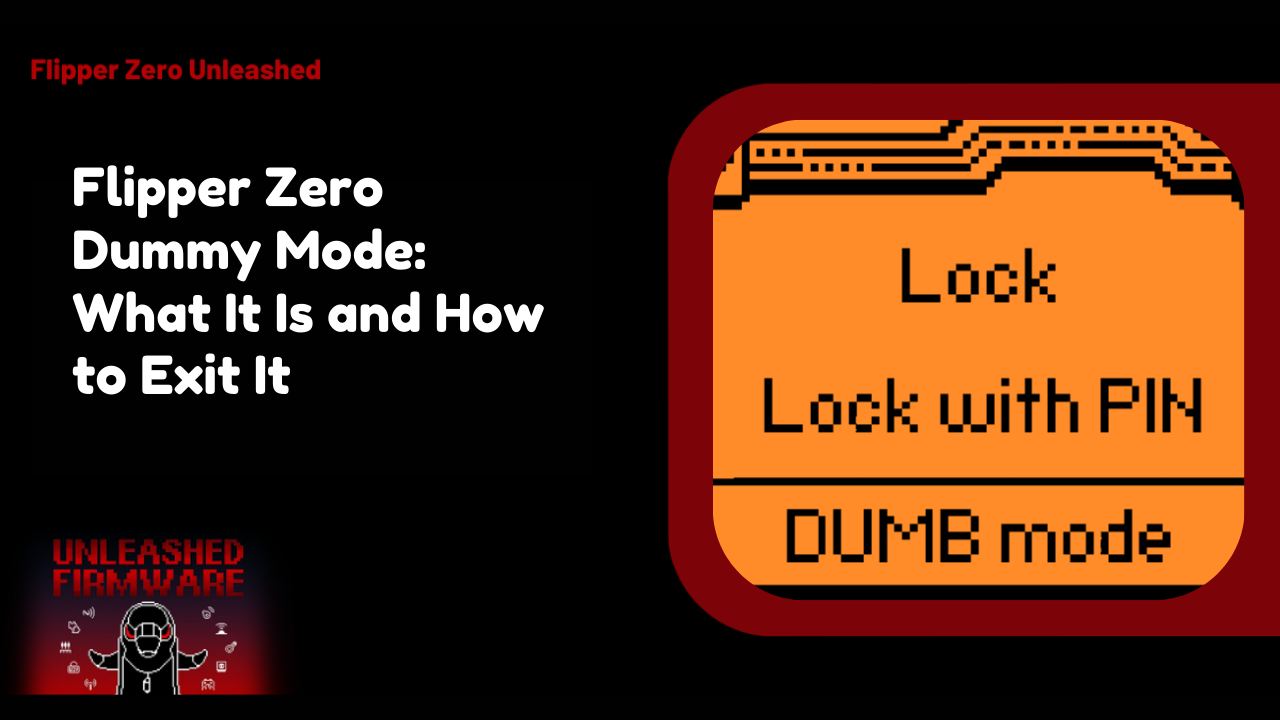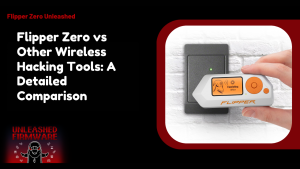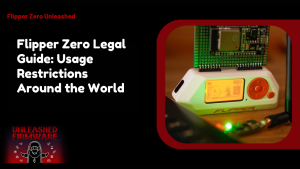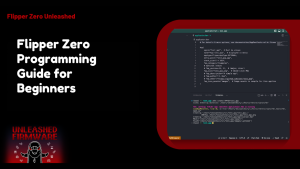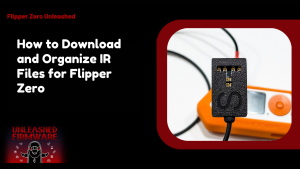Table of Contents
ToggleIntroduction
Ever powered on your Flipper Zero and felt like it just wasn’t… itself? That’s often a sign it’s in Dummy Mode. This mode is basically your device taking a pause when something isn’t right. It limits functions to protect the system so your Flipper Zero device doesn’t misbehave or get damaged.
What Dummy Mode Means for Your Device
When your Flipper Zero enters Dummy Mode, it temporarily restricts certain functions. You may notice that the screen behaves differently, buttons respond more slowly, or some apps simply won’t open. Essentially, it’s the device’s way of telling you Hold on, I need a moment to recover.
This mode doesn’t damage your Flipper Zero it just acts as a protective measure. During this period, you can still interact with the device lightly but heavy operations may not work.
Why Devices Enter Dummy Mode
Devices typically slip into Dummy Mode when they detect something unusual, such as firmware errors, incomplete updates, or sudden power interruptions. It’s a safety mechanism to prevent your Flipper Zero from performing operations that could corrupt data or brick the system.
Common Symptoms of Dummy Mode
You’ll know your device is in Dummy Mode if it remains in this state for an extended period, apps don’t open, or the screen displays unusual patterns. Buttons may respond inconsistently, or the device might freeze randomly. These are all signs that your Flipper Zero is in protection mode.
Other hints include failure to boot normally or limited access to certain features. Recognizing these symptoms early lets you decide whether to attempt a soft exit or safely turn off Flipper Zero to reset it.
What Causes Flipper Zero to Enter Dummy Mode
Ever wondered why your Flipper Zero suddenly acts like it’s taking a nap? Dummy Mode is usually your device’s way of signaling that something isn’t quite right. It’s like a little “pause” button that kicks in when the system encounters an issue. Understanding the causes helps you prevent and resolve the issue more quickly.
Firmware Glitches or Incomplete Updates
One of the most common culprits is a glitchy firmware or an update that didn’t fully install. If the system files are interrupted during an update, Flipper Zero may enter dummy mode as a protective measure. It’s essentially the device saying “Oops, I need a moment to sort things out!”
Keeping your firmware updated and ensuring updates complete without interruption can minimize this. And if your device ends up stuck, knowing how to turn off Flipper Zero safely can help you reboot it without creating more issues.
Battery or Power-Related Issues
Low or unstable power can also trigger dummy mode. If the battery level drops too low during operation or the device experiences a sudden power loss, Flipper Zero may freeze to protect itself. Think of it as your device taking a timeout to avoid damage.
To prevent this, always ensure the battery is charged before using your device for heavy tasks. And if you need to, you can confidently turn off Flipper Zero to recharge it safely without risking further glitches.
User Errors and Accidental Activations
- Dummy mode can sometimes be accidentally activated.
- Pressing certain buttons in the incorrect sequence or triggering hidden modes may cause your Flipper Zero to unexpectedly enter dummy mode.
- This is easy to do, especially when exploring advanced features.
- Being mindful of button combinations and learning your device’s shortcuts can prevent accidental activation.
- If dummy mode is activated, you can still safely turn off the Flipper Zero and follow the recovery steps without damaging your device.
How to Identify Dummy Mode on Flipper Zero
Sometimes your Flipper Zero might act a little off. That’s often a sign it’s entered dummy mode, a safe state where the device pauses certain functions to prevent errors. One of the easiest ways to notice it is through unusual screen behavior such as blank displays, frozen menus, or unresponsive icons.
Buttons might also feel sluggish or completely unresponsive, which is another red flag.
Screen and Button Behavior
When your Flipper Zero enters dummy mode, the first thing you might notice is unusual screen behavior. The display may freeze, flicker, or show only partial menus. Sometimes, icons may not respond, or the backlight may act strangely. These little glitches are your device’s way of saying, Hey, something’s off! Buttons may also become unresponsive or behave inconsistently.
Signs Your Device Is Not Functioning Normally
Besides screen and button issues, other subtle signs indicate your Flipper Zero is stuck in dummy mode. Apps may crash frequently, or certain functions may stop working entirely. Sometimes, your device might fail to boot properly or get stuck on a loading screen.
Being aware of these signs helps you act quickly. If your Flipper Zero seems sluggish or unresponsive, it’s a clue to perform corrective actions.
Checking Device Logs or Indicators
Many Flipper Zero models feature logs or indicators that display what’s happening internally. Reviewing these logs can pinpoint why the device entered dummy mode. You might notice error codes, unusual activity patterns, or failed updates.
How to Exit Dummy Mode
Exiting dummy mode on your Flipper Zero doesn’t have to feel scary. There are several ways to revive your device, ranging from gentle soft reboots to more powerful force resets. Choosing the correct method depends on how stuck your device is, and with the proper steps, you’ll have it running smoothly in no time.
Soft Exit Methods
Soft exits are the easiest and safest way to exit dummy mode. This involves gently rebooting the device or closing frozen apps. Often, simply holding down the power button for a few seconds and restarting will resolve minor freezes.
Soft exits are perfect when your Flipper Zero shows only slight screen glitches or unresponsive buttons. They allow you to turn off Flipper Zero or restart without losing any saved data, making this the first step in any dummy mode troubleshooting routine.
Hard Exit Methods
A hard exit is a bit stronger than a soft exit and is used when the device doesn’t respond to simple restarts. This typically involves holding down the power and function buttons simultaneously for 10–15 seconds until the device entirely shuts down.
Hard exits are helpful for more persistent dummy mode issues and ensure your Flipper Zero resets properly. After performing a hard exit you can safely turn off Flipper Zero if needed, giving your device a fresh start and improved responsiveness.
Force Exit Procedures
Force exits are the last resort for situations where soft and hard exits fail. This involves a more intensive reset, often requiring a combination of button presses and connecting the device to a power source to force a reboot. Use force exits sparingly, as repeated use may stress your Flipper Zero. Always follow proper steps and keep backups of any critical data.
Tips to Prevent Dummy Mode
Keeping your Flipper Zero stable starts with good habits. Preventing dummy mode is easier than fixing it, and small steps go a long way. Regular care ensures your device remains responsive, reliable, and ready for all your projects.
By following these tips, you can enjoy smooth performance without unexpected freezes or glitches. Simple practices, such as keeping your firmware updated, handling it gently, and performing occasional checks make a huge difference.
Keeping Firmware Updated
- Firmware updates are essential for avoiding dummy mode.
- They patch bugs, improve stability, and add new features that help your device function correctly.
- Make it a habit to check for updates regularly and install them as soon as they’re available.
- Updating firmware fixes potential dummy mode triggers and keeps your device running smoothly overall.
- After an update, your Flipper Zero should function more smoothly.
Safe Device Handling
How you handle your Flipper Zero matters. Avoid pressing buttons too hard, dropping them, or exposing them to moisture or extreme temperatures. Rough handling can trigger dummy mode or other errors that affect performance. Treating your device gently ensures all buttons and sensors remain functional.
When it’s time to learn how to turn off Flipper Zero, you’ll know the device will respond appropriately and shut down safely every time.
Regular Maintenance Practices
Regular maintenance keeps your Flipper Zero in top shape. Cleaning the ports, checking battery health, and rebooting occasionally prevent glitches and dummy mode from occurring. Taking these small steps makes your device more reliable and extends its life.
Following a consistent maintenance routine ensures your Flipper Zero is ready for action. It allows for smooth operation whenever you need to turn it off or use it throughout the day.
Conclusion
Dealing with dummy mode on your Flipper Zero doesn’t have to be stressful. By understanding the differences between soft, hard, and force exits and taking proper preventive steps such as updating firmware, handling your device with care and performing regular maintenance, you can keep your Flipper Zero running smoothly.
Remember whether you need to turn off the Flipper Zero, figure out how to turn it off or perform a quick restart doing so safely protects your device and data.
FAQs
What is Flipper Zero dummy mode?
Dummy mode is a state in which the device becomes unresponsive or exhibits abnormal behavior, often due to firmware issues, battery problems, or accidental triggers.
How do I know if my Flipper Zero is in dummy mode?
Look for frozen screens, unresponsive buttons, app crashes, or devices that won’t boot properly. These are classic signs of dummy mode.
Can dummy mode damage my device?
Usually, dummy mode doesn’t cause permanent damage, but repeated forced exits or improper handling could stress the system or risk data loss.
How do I safely exit dummy mode?
Begin with a gentle exit, such as rebooting the device. If that doesn’t work, try a hard exit or, as a last resort, a forced exit. Always save data first when possible.
Why does Flipper Zero enter dummy mode unexpectedly?
Common causes include firmware glitches, low battery accidental button presses, or corrupted apps. Keeping your device updated and handling it carefully reduces these occurrences.
Can a firmware update fix dummy mode?
Yes! Firmware updates often fix bugs and stability issues that may trigger dummy mode, making updates one of the most effective preventive measures.
Is frequent rebooting necessary to prevent the device from entering dummy mode?
No, only reboot when needed. Regular maintenance and proper handling are more effective than constant restarting.
Will exiting dummy mode erase my data?
Soft and hard exits usually keep your data safe but a forced exit might interrupt unsaved processes. Always back up important files when possible.
Latest post:
